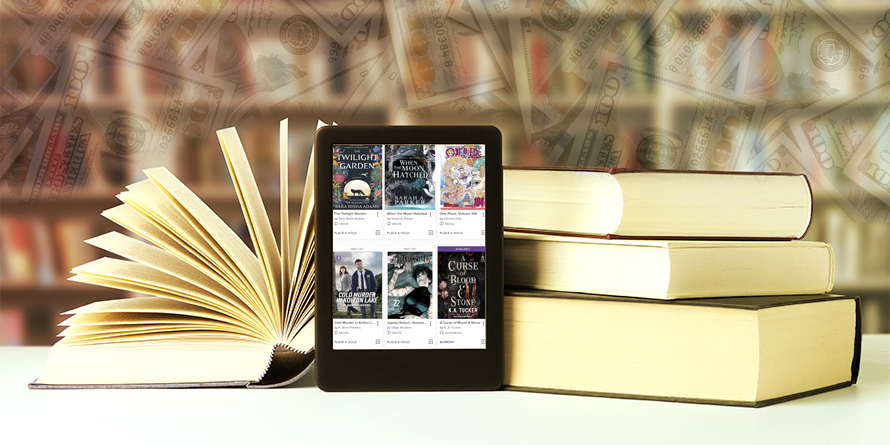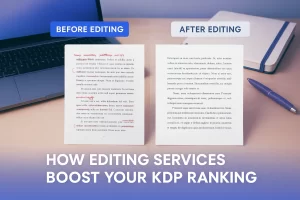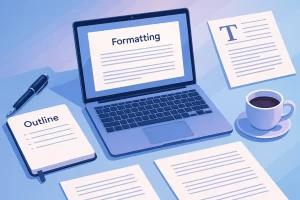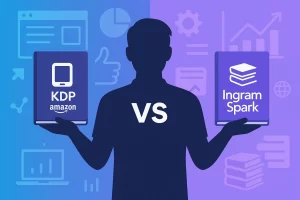If you are a new publisher and managing a startup publishing firm, the choice of making either print, e-books, or audiobooks appears to be a pivotal decision. If you opt to print books, you may face various challenges in the initial stage, ranging from mounting paper, complex and expensive logistics, high material expenses and printing costs, and distribution challenges. Market saturation, another publishing hassle, makes it difficult for a new book to gain prominence and visibility without executing a strong marketing strategy.
Conversely, digital publishing benefits novice publishers as it eliminates the costs associated with printing, storage, and physical distribution. Consequently, self-published authors get a highly cost-effective entry point. With audio and e-book publishing, the publishers also benefit from global accessibility and distribution. Digital publications in different formats, such as audio and e-books, promptly reach digital marketplaces such as Amazon Kindle, Apple Books, and Kobo. Digital manuscripts are accessible to a wide-reaching audience without encountering geographical barriers or shipping delays.
Innovations in digital publishing continue to expand the industry’s reach as professional book publishing services have produced high-quality and well-structured digital and print formats. The e-books and audiobooks now dominating the publishing industry have increased book sales globally. According to the Statista Market Forecast report, e-book sales are estimated to reach $23.12 billion by 2026. The global e-book is observing a strong upward trend in digital reading formats. Tech-driven Gen Z and Alpha readers prefer reading a wide genre of e-books and audiobooks comprising romance, fantasy, and sci-fi. The recent statistics reveal that the global number of e-readers will reach 1.2bn by 2030. Updated statistics of the audiobook market reveal that audio readers are projected to reach 1.8bn users by 2030. As e-books have captured global niche markets, the anticipated revenue in the e-book market will mount up to US$14.92 bn in 2025. The annual revenue that the global audiobooks market will earn in the current year is estimated at US$9.84bn.
The potential benefits of leveraging digital publication, such as global accessibility and distribution, and a low price option, have made audio and e-books the best option for budget-conscious readers. These digital formats are portable and convenient, as readers no longer need to carry around books. Instead, they have the flexibility to read multiple books on an e-reader device. With audiobooks, readers with multitask continue to benefit. AI narrator, along with high sound effects and music, enhances engagement and offers a mesmerizing manuscript listening experience.
The Evolution of Reading Formats
Brief History of Print Dominance
The progression of reading formats began from primitive manuscripts written on papyrus. The documents were used in ancient Egypt and Greece to inscribe important texts. With difficult and illegible fonts and limited information, the manuscript format failed to capture the reader’s attention. Developments in print introduced another book format known as the codex, a hardcover book that consists of individual pages. This book format paved the way for printing services to adopt a standard book format, and it gave rise to the mass production of books. The development of the printing press in the 15th century was a landmark achievement for publishers, as it enabled them to print more paperbacks quickly at a lower cost.
In the 20th century, paperbacks and hardcover books were introduced to readers. The paperback volume emerged in the 1930s, was economical to produce, and could be delivered to consumers in different regions and locations with ease. The hardcover copy was considered a prestige item for businesses; therefore, they used hardcovers for special edition books.
Rise of Ebooks in the early 2000s
The last quarter of the 20th century brought rapid expansion in book publishing. The digital era, beginning in 1971, influenced publishers to employ innovation and digital technology to create digital versions of books. In the 2000s, the leading tech companies such as Apple, Sony, Amazon, and Google stepped into the digital marketplace to promote e-books to a wider literary community. To enhance e-books’ accessibility and bring convenience to consumers, modern publishing companies developed electronic devices such as e-readers, smartphones in 2000. It marked a significant step towards revolutionizing the publishing industry.
Surge of Audiobooks in the 2010s and beyond
The modern digital era further expanded e-books into multimedia elements such as book video trailers, audiobooks, and interactive graphics. The escalation of audiobooks in the 2010s involved professional audiobook services, Audible, and the Kindle platform, using technology to maximize audiobook production. Such as using Whisper sync for Voice, which enables users to smoothly switch between reading and listening to the same content. Moreover, some audiobooks with AI-generated narration with immersive soundscapes, and high-quality sound and tone bring a captivating reading experience.
Hybrid Readers Using More than One Format in 2025
Flexible and user-friendly digital books inspire tech readers using electronic devices, mobile devices, and tablets to get seamless access to physical books, e-books, and audiobooks. The readers integrate physical and digital formats based on their personalized reading habits, choices, and lifestyles. Hybrid reading brings increased flexibility to learners with personalized learning opportunities. They utilize online resources to read print and digital books while commuting, working out, or doing household chores. Hence, it brings an enjoyable, cohesive reading experience.
Print Books: The Timeless Classic
Advantages:
Tangible Reading Experience
In the digital learning era, many readers still prefer reading print books. Though digital screens are visually inspiring for tech readers, they lack the rich sensory experience that printed books offer. For instance, the printed book brings a tangible physical experience that makes the audience feel the value and texture of holding their copy. An exclusive aroma of old books, their pages, and fresh ink evokes strong memories. Even the layout, fonts, and color of the paper and visually pleasing book covers enhance emotional connection and lead to an immersive reading experience. Thus, digital manuscripts cannot fully replicate well-designed and captivating print books due to their exclusive qualities.
Collectibility and Resale Value
The bestselling hardcover fiction and memoirs have a good market value. The retail value of print books is determined by numerous factors, such as the first edition that appeals to a vast audience, new condition books with no signs of physical defects or content flaws, and out-of-print manuscripts. The other significant factors include audience changing reading trends and choices, and an author or publisher’s fame increases market demand for the proposed manuscript.
Reduced Screen Fatigue
The print books help lessen cognitive load. The readers feel a deeper connection and engagement in the text. Reading print books eliminates eye strain, dryness, and discomfort. Moreover, the print version influences readers’ minds and thoughts. It is observed that the readers tend to remember information better from physical books as compared to digital manuscripts. Thus, physical books increase tangible engagement and an absorbing reading experience.
Disadvantages
As compared to e-books, less mobile and heavier to carry. The readers find it difficult to carry huge manuscripts as they take up a large physical storage space and create clutter. The other drawback that traditional publishing and distribution services encounter is paying upfront costs, such as printing, shipping, and warehouse expenses.
Current Printing Trends
Rise of Sustainable Publishing (Eco-Friendly Paper)
To let self-publishers learn how to publish books using eco-conscious printing practices, the marketers and printing services help indie publishers adopt sustainability in printing. The leading publishing services are employing eco-friendly printing methods to reduce the damage caused by printing to the environment. Expert printers at David McKay Publications utilize sustainable publishing approaches that include recycling, using renewable resources. Recycled and FSC-certified paper is considered an uncomplicated, eco-friendly method for manuscript printing. A simple procedure involves typographers removing pulp, which reduces hazardous waste dumps. Using certified paper and waterless printing helps in forest management. Additionally, the publishers protect the environment from carbon emissions and waste generation.
Employing Eco-Friendly Inks
To introduce eco-friendly printing practices, skilled printers have switched to plant or soy-based inks. An eco-friendly printing ink manufactured from soybean oil offers a renewable substitute to petroleum-based inks. Soy ink produces accurate colors with fewer organic compounds, which helps improve paper recyclability. Moreover, publishers also use water-based inks for book production. The eco-friendly ink utilizes water as its main solvent, substituting toxic organic solvents. With low VOC organic compounds, the ink produces vibrant colors, and it is easier and economical to clean up in contrast to traditional ink.
Limited Editions and Special Covers Attract Collectors
As more readers are opting for e-books, professional book writing services offer value-added print editions. It includes creating high-quality physical versions with artistic book covers and layout, unique designs, striking illustrations, and special bindings increases the aesthetic value of the published and printed versions. Thus, limited and artistically pleasing editions bring up high investment potential for book publishers.
Print On Demand Printing Techniques
Modern publishing houses implement POD services that print books as required by the client. Print on demand is an effective digital printing model for startups and independent publishers. Since POD is a low-risk publishing model, startup publishing firms no longer need to pay upfront costs, inventory, and other publishing expenses. POD quickly generates small quantities or single printed copies in less time. The digital printing technology ensures that the printed manuscripts are promptly delivered globally. Thus, employing print-on-demand publishing services brings flexibility to authors and self-publishers and ensures a wide distribution reach.
Ebooks: The Digital Convenience
Advantages
Portability and Convenience
Whether you are a regular traveller or an enthusiastic reader, you prefer keeping an e-reader device that carries numerous books in a single device. The reader has the flexibility to adjust font size, background, and light to read online or engage in extensive research. Amazon Kindle or iBooks are more accessible and are instantly downloaded. E- books are affordable and have a minor cost in comparison to print. E-books are eco-friendly and lessen the environmental impact of traditional book production and printing.
Disadvantages
Along with benefits, the readers encounter potential issues such as eye strain, screen fatigue, and headaches. The readers have to pay a high cost for purchasing advanced models of e-readers and other apps. To keep the device charged, users require a power source charger. E-books cause digital distraction while reading online. The readers fail to develop sensory experience and emotional connection with a digital book as compared to a print book.
Current E-book Trends
AI-Powered Personalization
Top-rated book publishing services, such as David McKay Publications, employ current e-book publishing trends. The publishers utilize AI writing tools to refine the content, depending on readers’ changing reading trends and preferences. With an AI algorithm, the e-readers get personalized recommendations to read either an e-book, an audio version, or a printed manuscript. Furthermore, the interactive features, such as embedded sound clips, video animations, and graphics, bring an enchanting reading experience.
Integration with smart devices and e-readers with eye-friendly screens
Skilled publishers facilitate users about user- user-friendly interface. Customized, easy-to-understand features in electronic devices allow readers to regulate fonts, colors, and other layout components that reduce reading discomfort. E-readers, lightweight with sleek designs and eye-friendly screens, alleviate eye fatigue. The touch screen display allows readers to adjust the screen size to read different types of content.
Growth in Subscription-Based E-book Services
Professional book services assist publishers and authors in opting for subscription-based e-book services. For this purpose, the authors create a publishing account on Amazon’s Kindle to publish their manuscripts on Amazon’s Kindle or other online publishing platforms. Along with publishing, authors get e-book subscription access. It includes having access to online libraries for a monthly fee to read numerous categories of e-books. The subscription services also include payment modes. The publishers are paid according to the quantity of pages read. Royalty-based system allows publishers to earn a percentage of the subscription revenue or a fixed royalty payment based on increased book sales.
Audiobooks: The Multitasker’s Favorite
Advantages
Listening to audiobooks benefits users with varying professions and diverse abilities. People engaged with multitasking, such as travelling, doing house chores, or executing physical exercises, prefer hearing to audio-formatted books. The audio narrative, with high-quality voice acting and compelling storytelling style, and other interactive elements, offers an enticing reading experience. Hands-free and screen-free listeners feel relaxed and remain motivated towards the task. Moreover, the audible apps provide access to an extensive library of audio content consisting of different genres. Readers have the flexibility to download and listen to audiobooks and podcasts.
Disadvantages
Listening to audiobooks reduces the concentration of users while engaging in multitasking. The listeners find it challenging to skim or reread sections and difficult to recall the content. Moreover, the low narrator voice and performance make audio narration unengaging and boring for readers. In comparison to print books, audiobooks lack the physical and sensory experience. Readers remain detached and fail to develop a cognitive connection with the content.
Current Audiobook Trends
The audiobook market is experiencing fast-paced progress as driven by changing reading choices and trends of demography. Prominent publishing companies such as David McKay Publication are employing current audio publishing trends. Skilled professionals using high-quality narration, voice, tone, and emotion that bring stories to life. The top-notch audiobook publishing services leverage AI technology to generate clear and comprehensible Professional AI narration enhances emotional delivery and keeps listeners engrossed in the story.
David McKay Company helps new startup publishing firms to boost their audiobooks’ visibility through SEO marketing strategies. The authors, marketers, and sales team work in collaboration and create relevant keywords that boost organic traffic on websites and increase audiobook discoverability on online platforms. A professional and flawless narration increases global distribution of audio audiobooks and brings high conversions and sales. The publishing services specialize in creating audiobooks in broad genres, various formats, and production styles. They have merged podcasts and audiobooks. It includes extracting and compiling sections from a book to form an engaging reading segment. A captivating podcast-style, combined with audiobook narration, keeps listeners immersed in the content.
Reader Demographics and Preferences in 2025
Which generations prefer which formats?
In today’s digital era, readers’ preferences have significantly changed. Demographics of varying ages have shown interest in reading print books, e-books, listening to audiobooks, podcasts, and watching video book trailers. For instance, Gen Z tech-driven readers have grown up using technology for different purposes. Tech-savvy young audience expects immediate access to books. Therefore, opting for audio and e-books and other digital formats is their best choice. Millennial readers show varying reading habits. They prefer reading both print books and digital manuscripts. Baby boomers are less tech-savvy and prefer reading print books over e-books. Gen X readers are more technically literate than Boomers. They utilize technology such as smartphones, tablets and electronic devices to read e-books and other digital books. Baby boomer readers, though, feel comfortable with the printed version; they have adapted technology and digital platforms for reading.
Authors & Publishers: Which Format Benefits Them Most?
Self-published authors and professional publishing services opt for traditional, self-publishing, or hybrid publishing models based on their financial goals. Traditional publishing is lucrative for new publishers as it maximizes book reach, provides potential opportunities to increase book distribution on a large scale, and offers profitable sales. A publisher who opts for self-publishing uses online platforms such as Amazon KDP, ACX, or IngramSpark that provide autonomy and creative control in managing manuscript production, publishing, and marketing. Employing online publishing sites also offers print-on-demand services that bring high sales and royalty percentage. Regarding choosing the specific publishing format, the publishers and independent writers opt for either hardcover, paperback, EPUB, Kindle, or audiobooks based on market demands and choice, and trends of the target audience. Book formats, both physical and digital, increase readership and help publishers tap new markets to enhance their visibility. Digital formats such as EPUB and audiobooks promptly capture the growing digital market.
Recapitulate
The book publishing industry has experienced substantial growth over the past few years. The future of publishing is not about employing anyone of the publishing formats. In fact, the synergy of both print and digital publishing benefits both readers and publishers. Reading diverse formats of books enables readers to meet their unique needs. With printed books, the potential readers develop a sentimental bond and enjoy an immersive reading experience. E- books are considered the best choice for travelers who have easy access to numerous books through an e-book reader. Audiobooks are suitable for multitaskers and accessibility users. Driven by various factors such as changing reading trends and preferences of the audience, and financial goals, the publishing services opt for lucrative publishing platforms and diverse publishing formats. Let’s suppose you are a new publisher or an independent writer, you desire to seek professional book publishing assistance from traditional publishers. The publishing house handles the entire book publishing and distribution tasks efficiently. If you are an experienced self-publisher or entrepreneur, you can effectively establish your niche markets and promote your print and digital publication to a mass market. Some publishers find print books affordable; however, print versions are comparatively higher due to physical production, paper, printing, binding, warehousing, and distribution costs. The publishers who prefer Amazon publishing find digital publications economical and accessible.
Today, e-books have taken control of the entire book market industry due to their minimal production and distribution costs. The publishers also choose e-book publishing as it is eco-friendly. Additionally, self-published authors prefer Amazon’s Kindle, Kobe, Audible, and Scribd for different subscription models that attract a vast audience. Whereas the audiobooks are the most expensive, as publishers invest extensive amounts in delivering professional narration, high-quality production, and seamless distribution. Furthermore, it enhances digital engagement and helps authors expand their online presence and connect with a wide-reaching audience. Thus, adapting these different book publishing formats boosts the brand’s visibility and marketability, bringing new revenue streams, leading to high sales and profitability.




